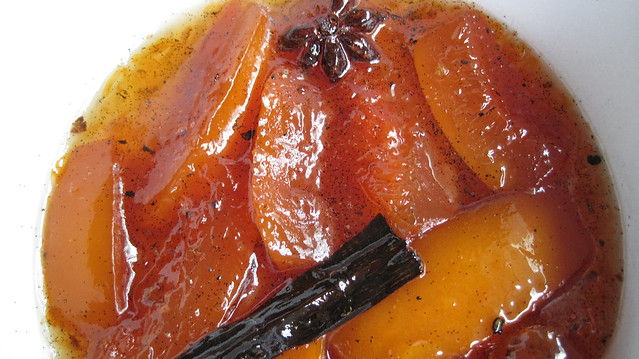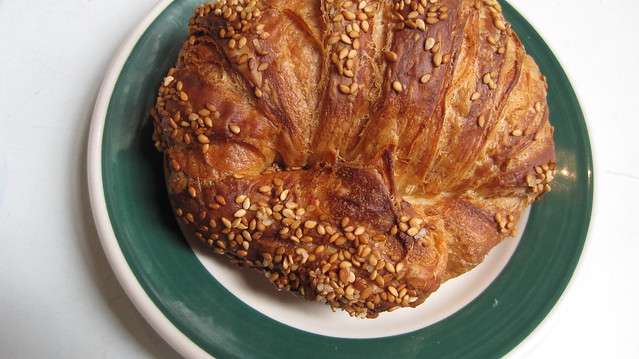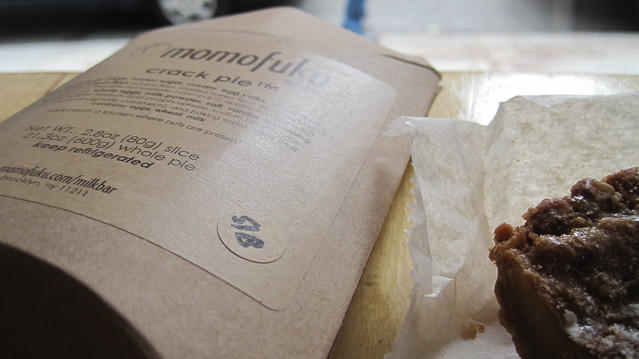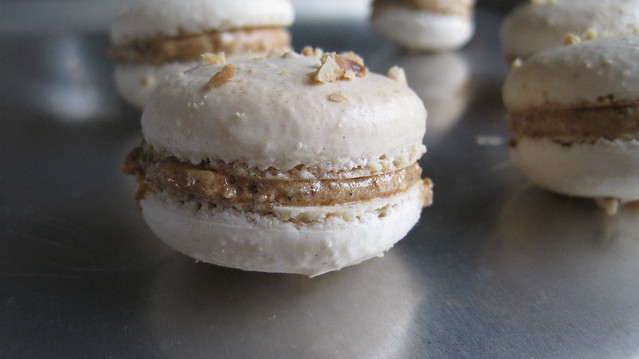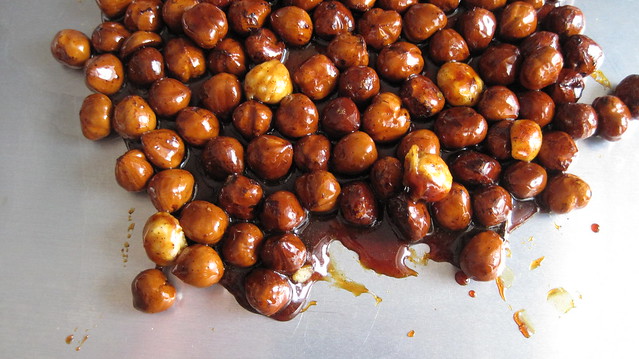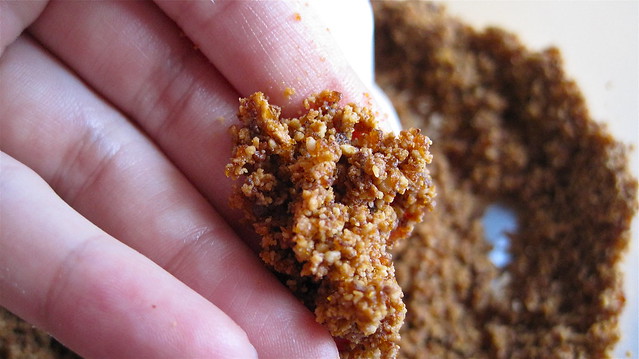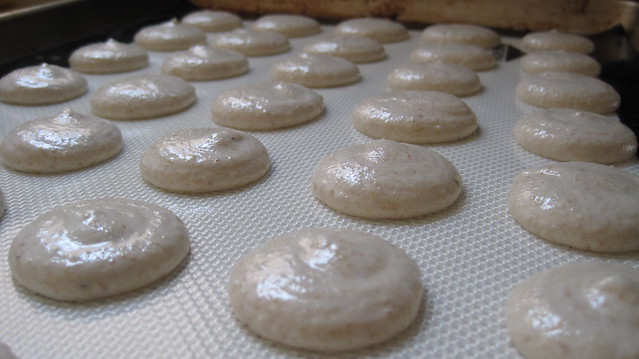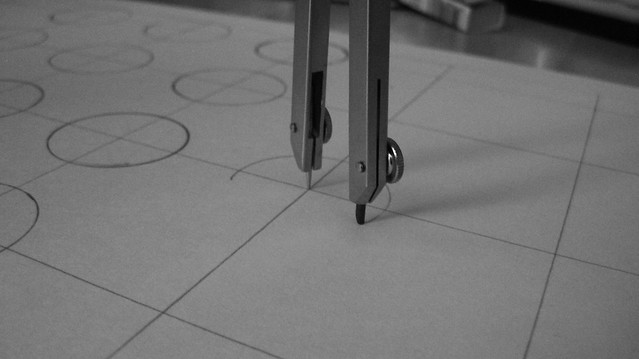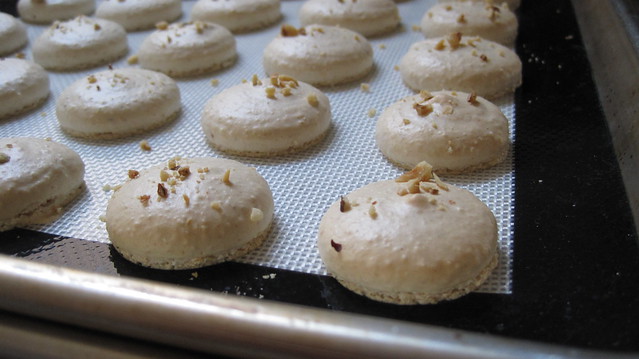These macarons were going to be stunners--ruffled and delicate, with the faintest rosy blush to them. But then, I stupidly didn't see a typo in the measurements for what it was (Pierre Hermé's typo, I should add, not mine). Three failed batches of sugar syrup later--all of them burnt and crystallized--I finally referenced Hermé's other recipes. I should have been adding ten times the water I had been. And, of course, I should have known sooner--7 g of water is a negligible amount--but when translating, I'd shrugged my shoulders. Hermé knows best, right? And by that time, my boyfriend was already at the stove with batch no. 4, only it was too late to measure the proper amount, so we just added water liberally and hoped that the excess would evaporate off. Things could have gone just fine from there, but I was just so frustrated--I forgot to add the second portion of egg whites to the almond powder before folding in the meringue. That became apparent very quickly. All I could do at that point was add the whites to the stiff, sticky mess at the very end, cursing all the while.
So, here they are--my not-so-pretty grapefruit-campari macarons. See how the feet stick out past the domes of their shells? Terribly over-mixed in all that confusion. Now, I could blame Hermé's editors or the fact that I wasn't working in my own kitchen--but really, I just lost my cool. I'd been looking forward to this all week--I'd made a special trip into the city for ingredients and spent the day before making some amazing candied grapefruit. So, even though things were finally going well with the meringue, I just wasn't with it anymore.
At least making these macarons was good experience--I candied citrus peels for the first time, made my first ganache filling, and learned a little about what makes for good white chocolate. Have you ever looked at the ingredients list on the average (or even a premium) bag of white chocolate chips from the grocery store? Chocolate in name only. The second ingredient is likely palm kernel oil, and if you keep reading, you won't see any cocoa-derived ingredients at all. How is that chocolate? Of course, being white, there won't be any cocoa solids in it. But cocoa butter--that's what makes the difference. I only noticed because Hermé calls for couverture chocolate, which is chocolate that is 32-39% cocoa butter. Now, cocoa butter is important if you're going to be tempering your chocolate, but I'm not sure that it's essential to macaron ganache. I might have to do some comparison testing. But I can say this much--couverture wafers are velvety and complex (at least for white chocolate) straight out of the bag. (I found E. Guittard couverture wafers at Dean & Deluca in SoHo--couverture is surprisingly hard to come by).
The ganache for these macs wasn't traditional. Instead of pouring hot cream over the chocolate, Hermé has you melt the chocolate in a double-boiler, heat a blend of Campari and citrus juices separately, add these to the chocolate, and then whirl it all in the blender for four minutes. Quite frankly, I wasn't crazy for the ganache. It was good, but I was hoping that the Campari and citrus would be more prominent. I'm not sure that I could have identified them without having been told that they were there first.
But the ganache was a great foil for the candied grapefruit, and maybe that was all it was meant to be. I was excited and a little intimidated by the prospect of candying grapefruit. I was afraid that it was going to be too bitter to eat. But it turned out to be really easy. Hermé's candied peels, like his ganache, aren't very traditional either. Ordinarily, you just cut the peel, pith and all, from the fruit's flesh for candying. Hermé has you take a centimeter of flesh off the fruit with the peel. Then it's just a matter of blanching the peel to rid it of some of its bitterness and simmering it in a sugar syrup for an hour and a half. The resulting candied wedges are jammy and intense. They have a nice bitter edge, which plays well with the subtle perfumes of the star anise, Sarawak pepper, and vanilla bean that infuse the candying syrup. The fleshy bits of the wedges are especially fruity--a good contrast to the actual peel.
For the macarons, the peels get cut up into tiny, bright grapefruit gems and then tucked into the center of the ganache of each shell. But I think these peels are brilliant unto themselves. I've been plucking them out of their syrup and eating them with my fingers. This morning, they found their way onto french toast. I'm sure they'd be great in oatmeal or with some yogurt too. And, if you really wanted to do something special, I'm sure that you could strain these, leave them out to dry on a rack for a good day or two, and then dip them in some melted chocolate, orangette-style. There's nothing like dark chocolate and candied citrus.
Candied Grapefruit Wedges
Adapted from Pierre Hermé's Macaron
Note: Sarawak peppercorns are a variety of Malaysian peppercorn, apparently prized for their distinct floral aroma. I was able to find a small package of them at Kalustyan's in Manhattan, and they are available online. I'm not sure how much of a difference they make. I'll experiment and let you know.
1 grapefruit, preferably unsprayed or organic
2 cups water
250 g granulated sugar
half a star anise
5 whole Sarawak peppercorns
half a vanilla bean
2 tbsp lemon juice
Prepare the candied grapefruit peels. Bring a medium pot of water to a boil. In the meantime, wash and dry the grapefruit. With a sharp knife, trim the ends and cut off the skin from top to bottom in strips, taking a good centimeter of grapefruit flesh with it. Put the strips in the water, return to a boil, and cook for 2 minutes. Then drain the strips and run them under the tap to cool them. Repeat this blanching process two more times.
Crush the peppercorns. Place them in a medium saucepan along with the water, sugar, lemon juice, and star anise. Split the half vanilla bean in two along its length and scrape the seeds into the pan. Add the empty pod. Bring the mixture to a boil over low heat. Add the grapefruit strips. Simmer gently on medium-low for about one and a half hours, partially covered. Pour the zests and syrup into a bowl and let cool. Cover the bowl with plastic wrap and leave in the refrigerator until at least the following day.
Strain and serve.
Optional finishes: lay the grapefruit wedges out on a cooling rack set over a half-sheet for at least 24 hours, then roll in granulated sugar or dip in melted dark chocolate.


